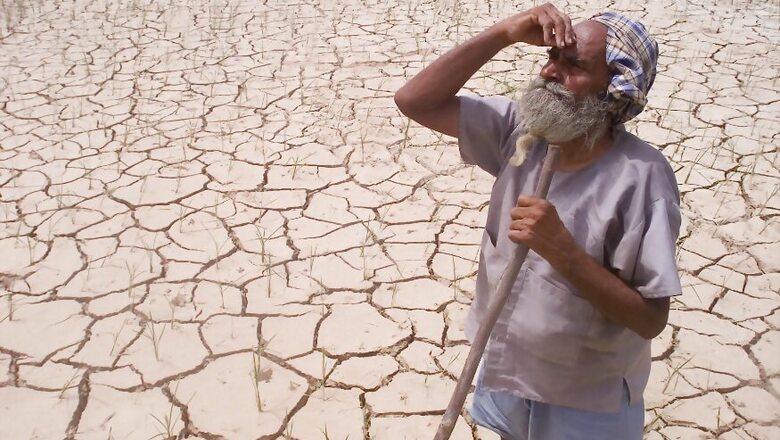
views
New Delhi: The World Resources Institute’s updated global water risk atlas has said that India was at a severe risk of water shortage. That ‘zero day’ when taps run dry – from both effects of climate change and groundwater exploitation – was not a farfetched scenario.
India’s battle with this crisis was steered by a host of factors which were not limited to just drinking water consumption. Around 90 per cent of India’s fresh water was used for agriculture. While the water footprint of industries were unchecked, farmer were forced to deal with depleting groundwater levels and low rainfall. What this did was trap a largely agri-based economy within increasing costs of cultivation and a dwindling produce — factors contributing to the current slowdown.
In an interview with News18, Mihir Shah, former member of the now-defunct Planning Commission and water conservationist, joined pieces of this crisis to sound an alarm for caution and cause.
Edited excerpts:
How do you explain India's water crisis?
India’s water crisis is a profound humanitarian crisis. But it is also a crisis of infrastructure and seriously affects the growth prospects of the country’s economy.
What are the challenges that India's farmers are currently facing in terms of water? How do we deal with them? Farmers grow water-intensive crops because they sell. Does Indian agriculture need recalibration in light of the water crisis?
India’s farmers face an unprecedented existential crisis, which has an inextricable link with water policy. While the Green Revolution made an enormous contribution to food self-sufficiency, we have not rejigged this policy for 50 years now. It is time for a change. About 3,00,000 farmers have committed suicide over the last 30 years, something unprecedented in Indian history.
The present farm paradigm needs a radical overhaul. We have incentivised farmers to grow water-intensive crops like rice, wheat and sugarcane, which take up 80% of irrigation water. Their yields are stagnating and costs of cultivation are shooting through the roof. We urgently need crop-diversification in the direction of traditional crops like millets, pulses and oilseeds and move towards alternatives to chemical farming.
How do you see India’s current water policy? Why the water ministry has been unable to deal with the current crisis?
For too long, India has suffered from “hydro-schizophrenia” in policy. We need to understand the inter-connectedness of different elements of the water cycle and plan for drinking water and irrigation together, groundwater and surface water together and water and wastewater together. Otherwise, sources of drinking water will continue to collapse as the same aquifer is used for irrigation, rivers will dry up as groundwater gets over-extracted in their catchment areas and water quality will fall as wastewater remains untreated.
The Ministry of Jal Shakti is a first step in the right direction, but much more needs to be done. We need to bring in professionals for many more disciplines to reflect the multi-dimensional nature of water. Water cannot be left to engineers and hydrogeologists alone. It needs agronomists, river ecologists, social mobilisers and water managers to come together. And this cannot be done by the government alone. All stakeholders need to work in a well-co-ordinated fashion, including academia, industry, farmers, civil society and panchayati raj institutions
In 2018, the World Bank estimated that three regions (Latin America, sub-Saharan Africa and Southeast Asia) will generate 143 million more climate migrants by 2050. Will falling groundwater levels increase such migrants in India? How can we conserve it or recharge it? Does it require a policy-level change?
India is the largest consumer of groundwater in the world. We have more than 40 million wells and tube wells. Managing this resource equitably and sustainably is India’s single-most important challenge. Groundwater is a common pool resource. Continuing its individualistic competitive extraction is only leading to falling water tables and declining water quality. Today, we have a groundwater problem of quantity or quality in 60% of our districts.
What we need to do is to map our aquifers at a scale that enables the primary stakeholders to come together to manage their own groundwater. This has been already done on the ground by millions of our farmers in different parts of India. The government needs to facilitate taking these proofs-of-concept to scale across the length and breadth of the country.
Should we less consume less water to save water?
Yes. For too long we have relied on the supply side to solve our water problem. The scope for further increases in supply of water gets more and more limited by the day. Our focus has to be on the demand side. Changing cropping patterns in farming and more recycling and reuse of water in industry. There are well-developed cost-effective technologies available for this purpose. It is the enlightened self-interest of Indian industry to adopt them.
Why is India's watershed programme a cause for concern?
India’s watershed programme is the single-most important water programme. By focusing on the health of catchment areas and encouraging local water harvesting, it holds the key to solving India’s water problem. The only concern is that in recent years, the programme has been somewhat put into the back-burner. The government must ensure investments in this programme are rapidly increased and civil society organisations and farmers are actively engaged for its effective implementation.



















Comments
0 comment